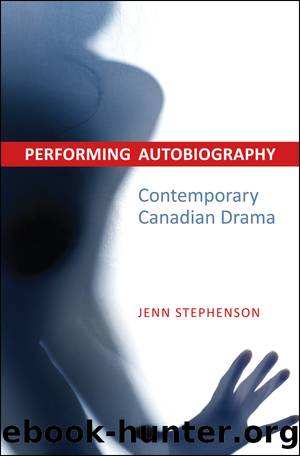Performing Autobiography by Jennifer Stephenson

Author:Jennifer Stephenson [Stephenson, Jenn]
Language: eng
Format: epub
Tags: DRA013000, LIT013000, LIT004080
Publisher: University of Toronto Press
Published: 2013-12-15T00:00:00+00:00
Chapter Five
Self-Authoring Characters in Recursive Autothanatography: In On It
Death is both promised by autobiography and explicitly excluded from it. As the writing (graphy) of life (bios), autobiography can never be fully synchronous with life itself, being necessarily limited in its scope of apprehension at the beginning of life and at the end. At both these extremes of the thread of life, there arises an inassimilable gap between the temporal position of the autobiographical author and that of herself as autobiographical subject. It is at these terminal points that the primary experience of life slips the grasp of the secondary recording of that experience. In the beginning, the earliest years of life are clouded by infantile amnesia, with reliable long-term memories only emerging between the ages of three and six.1 Sifting the foggy landscape to identify and describe oneâs first memory is a potent cliché of the genre.2 Likewise, the documentation of oneâs last moment is also elusive. Philippe Lejeune wonders about the last page of the thirty-five-year diary of French poet Jehan Rictus marked by âblack ink congealed at the bottom of the last page of [his] last notebook. Did he knock over his inkwell as he died? We will never know â the answer is drowned in the shadow of death.â3 This is the problem of death and autobiography. Although one might continue to document oneâs life right until the very end, creative synthesis of that end into summary is impossible. One cannot encompass the experience of oneâs own death. âThere can be no phenomenology of death ⦠Death is radically resistant to the order of representation.â4 And yet, in the face of this impossibility, autobiographers persist in attempting to write about death. For the autobiographer engaged in the work of sorting out a life, it is almost impossible to avoid consideration of death as the inevitable end of that life and of that work. Jeremy Tambling suggests that indeed death, rather than life, colours our understanding of selfhood and âit might be better if we started with the assumption of death working through the living, and not dissociated, therefore, from our sense of the present.â5 Nancy K. Miller sums up this perspective, asserting that âevery autobiography ⦠is also an autothanatography.â6
Autothanatography, which replaces âbiosâ (life) with âthanatosâ (death), manifests in two distinct modes, depending on how the topic of death is construed. In one mode, autothanatography traces the time up until death, engaging the subject in the process of dying. As Susanna Egan notes, quoting anthropologist Robert Murphy, âthe apprehension of mortality is a condition of our consciousness, a first premise of our sense of time, an axiom in our grasp of selfhood, a constant factor in all our plans, and a thread that is woven through the very fabric of our being.â7 Apprehension of mortality, however, becomes acute when the autobiographical subject is terminally ill. Eganâs examples of process-based autothanatography include Christina Middlebrookâs Seeing The Crab: A Memoir of Dying (1996), Eric Michaelâs Unbecoming (1997), and Barbara Rosenblum and Sandra Butlerâs Cancer in Two Voices (1996).
Download
This site does not store any files on its server. We only index and link to content provided by other sites. Please contact the content providers to delete copyright contents if any and email us, we'll remove relevant links or contents immediately.
Cecilia; Or, Memoirs of an Heiress — Volume 2 by Fanny Burney(31869)
Cecilia; Or, Memoirs of an Heiress — Volume 3 by Fanny Burney(31852)
Dialogue by Robert McKee(4321)
The 101 Dalmatians by Dodie Smith(3451)
Bound by Hatred (The Singham Bloodlines Book 2) by MV Kasi(3024)
The Art of Dramatic Writing: Its Basis in the Creative Interpretation of Human Motives by Egri Lajos(3015)
Harry Potter and the Cursed Child - Parts One and Two by John Tiffany(3003)
The Beautiful Boys: A High School NA Reverse Harem Paranormal Bully Romance (Shadowlight Academy Book 1) by Gow Kailin(2828)
Angels in America by Tony Kushner(2595)
Carrie's War by Nina Bawden(2431)
A Clockwork Orange by Anthony Burgess(2412)
Unlaced by Jaci Burton & Jasmine Haynes & Joey W. Hill & Denise Rossetti(2325)
The Femme Playlist & I Cannot Lie to the Stars That Made Me by Catherine Hernandez(2246)
Open Book by Jessica Simpson(2204)
Drama by John Lithgow(2189)
Outside Woman (BWWM Amish Romance) by Stacy-Deanne(2083)
Terrorist Cop by Mordecai Dzikansky & ROBERT SLATER(2036)
Yerma by Federico García Lorca(2016)
Leo's Desire by Sundari Venkatraman(1897)
